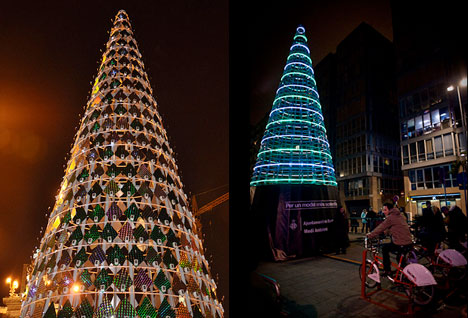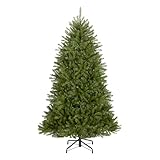Should I Buy a Real Christmas Tree Or an Artificial Christmas Tree?

Which do you prefer?
Depending on which people you talk to, the debate over whether or not to have a real Christmas tree is absolutely "Yes" or absolutely "No".
Most people are Real Tree proponents. They say that artificial trees (fake trees) are made from vinyl, which is very difficult to recycle, and that most are made in China. They point out that real Christmas trees are traditional, produce oxygen, provide farm income for small plots of land and are grown right here in the U.S.
The Artificial Tree proponents say that real trees are a hassle to deal with and are messy, and that a decent artificial tree lasts for years, is easy to set up, and the fake trees look more realistic every year. They also say that artificial trees allow a person who has allergies to still enjoy a Christmas tree.
Who's right?
Well, it's like politics. Regardless of which side you're on, the other side can't possibly have their heads on straight.
I'm on the fence looking at both sides. While I love real trees and have always had real trees, my allergies are getting in the way. So I've become more and more interested in an artificial tree. I have also discovered that at least one American company, Balsam Hill, makes artificial trees; with some TV morning shows and talk shows using these trees, they must be pretty nice looking. (If you know the names of more American-made tree companies, I would be glad to add their names.)
While buying an artificial tree that's been made in the U.S. helps American workers keep working, and that's a wonderful benefit, with this particular product there's more to it than that. If an artificial tree is made in China, the possibility of lead poisoning increases, as manufacturers of Christmas ornaments, wreaths and trees seem to be more prone to substituting materials than in other types of manufacturing. The factories have almost non-existent safety measures to protect employees, so the workers are also constantly exposed to the lead hazard.
Real and artificial trees do each have their qualities. While real trees can be fully recycled, artificial trees are almost impossible to recycle. Artificial trees are easier to set up and take down. Real trees fill your house with that wonderful fresh pine scent.
You may think that artificial trees provide more fire safety, but they only delay a fire by a small margin. Even with the artificial tree having flame retardant, that tree can go up in flames almost as fast as a real tree that's been allowed to dry out. (See the video below for an example of how quickly a tree burns.) Fire is by far the biggest danger, so check your tree lights to make sure they are safe, and keep either type of tree away from fireplaces and other sources of heat. If you have a real tree, you can make a "fire retardant" that will help your tree to remain green longer than it would otherwise. The recipe is at the Burn Institute.
Artificial trees usually weigh less than real trees. So they are safer around small children if there's a possibility of the tree falling on them.
Real evergreen trees have been used in mid-winter celebrations in Scandinavia for several thousand years. Nobody knows for sure when the tradition of including trees in the celebration began, but it has been practiced with enthusiasm since then.
The first artificial trees were made in Germany in the late 1800's with goose feathers acting as pine boughs and needles; needless to say, they didn't look very much like trees. The first U.S. artificial trees were made by a toilet brush company in the 1930's. (It was in the Sears Roebuck catalog, so it must've at least been colored green and tapered as it reached the top.)
If your only reason for considering artificial trees is that your allergies increase during the holiday season, you can do some preparation that might help to reduce the allergens. Before your tree comes into the house, if possible, have someone without allergies thump it on a hard surface several times to dislodge dust and pollen that can cling to the branches. You can also use the blower end of a shop vacuum to blow dust and loose needles from the branches of the tree. Once the tree is indoors, limit the time it's displayed to less than two weeks. Trees that are in a warm room for as long as two weeks can release spores from mold that lives in or on the bark. (Out of doors, in colder weather, the mold would normally be dormant until spring.)
Whichever tree you choose, for whatever reasons, may you and yours enjoy a very merry Christmas, and a happy and healthy New Year.









